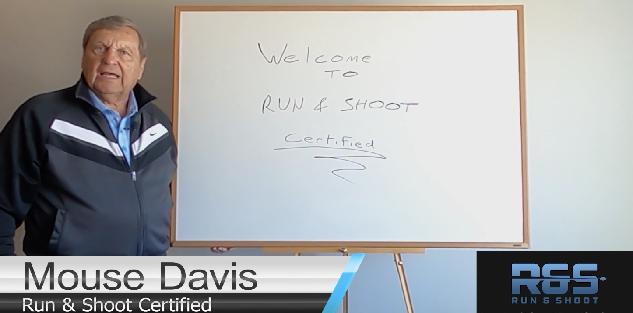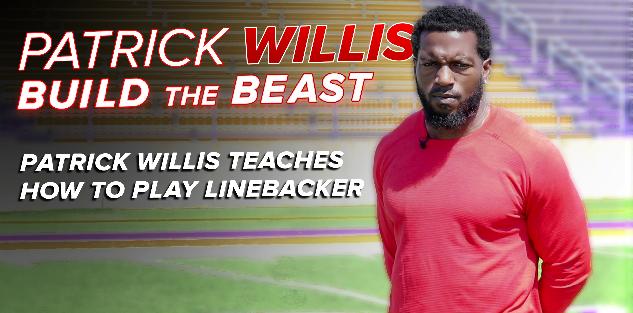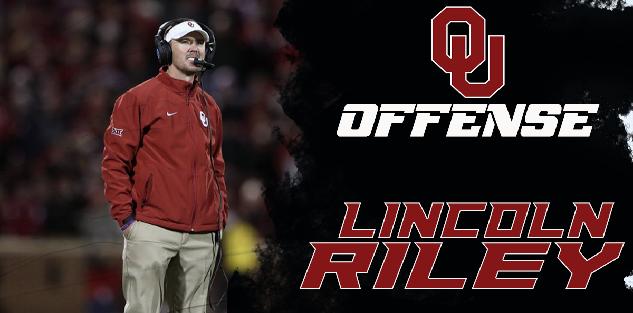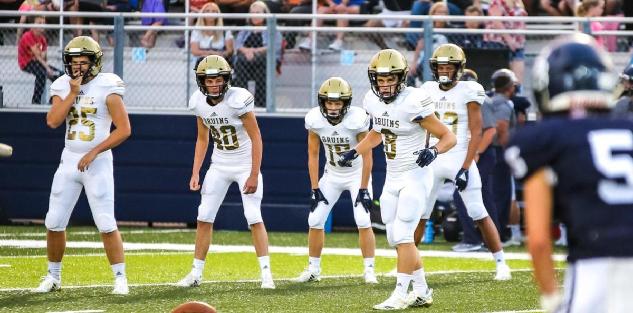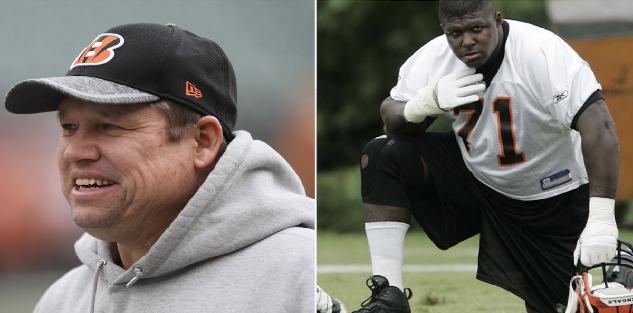Featured courses
- Jim Thorpe Award Winner Jahdae Barron’s 4 Drills for Dominating Receivers by Grant Young
- 5 Tips to Improve Your Football Game Plan by Andrew Dohre
- Game Changer RPO Football : Wing-T Offense by Andrew Dohre
- Mastering the Pass Rush: Expert Drills and Progression Tips from UCLA’s Coach Ikaika Malloe by Andrew Dohre
- 3 SPO’s to Protect the Passing Game and create opportunities in space by Keith Grabowski
- The Art of Running the Corner Route- Coaches and Players Prespectives by CoachTube Staff
- Evolve your Defense with Quarter, Quarter Half to Stop RPO by Coach Grabowski
- Top 10 College Football Players to Watch for in 2022 by Alec Burris
- Clemson vs. Syracuse Matchup of the Week by Keith Grabowski
- Sprint Out Passing: Move the Pocket for Success by Keith Grabowski
- Unlocking the True Potential of Your Special Teams Play by Keith Grabowski
- The Most Important Components of Air Raid by Keith Grabowski
- 4 Plays that Benefit from Bunch Formations by Keith Grabowski
- 3 Third Level RPOs for Explosive Plays by Keith Grabowski
- The Role of the Screen Game in Explosive Offense by Keith Grabowski
- The Chess Match: Win on the Perimeter (Part 1) by Coach Grabowski
- Unlocking the Power of Gap Manipulation to Limit Explosive Plays by Keith Grabowski
- TCU’s 3-3-5 and facing bigger personnel by Keith Grabowski
- Elevating Your Team: Strategies from Coach Matt Ruhle by Keith Grabowski
- 7 RPO’s for your playbook by Coach Keith
- Beyond Quarters - The Need For Additional Coverage Concepts by Keith Grabowski
- 5 Core Offensive Priniciples for a Winning Football Formula by Keith Grabowski
- Win Downfield - Attacking Different Areas Deep with 3rd Level RPO by Coach Grabowski
- WAKE FOREST’S UNIQUE RPO GAME by Keith Grabowski
- Adjustments to Defeat the Tite Front by Keith Grabowski
- Attack Defenses with The Versatile Y-Cross Concept by Keith Grabowski
- Play Action is a Cheat Code! - 5 Play Action Concepts to Increase Your Expected Points by Keith Grabowski
- Question from Rutgers OC - What does your offense say about your coaching? by Keith Grabowski
- Gap Schemes vs. Tight Fronts, Play Action Shots and Misdirection by Coach Grabowski
- Setting up your young Qb for success by Keith Grabowski
- The Hot Gap plus 3 Gap Scheme RPO’s to Stress the Defense by Keith Grabowski
- How Football Coaches Can Build A Game-Changing Special Teams Unit by Grant Young
- Master the Art of Quick Passing for High Completion Percentages by Keith Grabowski
- How to Be an Influential Football Coach by Grant Young
- How to Maximize Tackling Efficiency within Scheme by Keith Grabowski
- Offensive Drills of the Week by Keith Grabowski
- How a Stoplight Can Make Your Fly Sweep Takeoff by Keith Grabowski
- Keep your Drills Fresh and Your Skills Developing - Offense by Keith Grabowski
- Coach Kevin Kelley, Outside The Box by Keith Grabowski
- Want your defense to get off the field after third down? Sims and Creepers are the answer! by Keith Grabowski
- Create More Turnovers with Circuit Training & Win More Games! by Keith Grabowski
- Devastate the Defense with TE RPOs by Keith Grabowski
- Red Zone adjustments by Keith Grabowski
- CoachesClinic.com Featured Matchup: Cincinnati vs Indiana by Caleb Hopkins
- 3 NFL ZONE RUN PLAYS FROM WEEK 7 by Alex Kirby
- Sonny Dykes Teaches You How to Put Together an Offense by Coach Grabowski
- FIVE REASONS TO RUN THE 3-3 DEFENSE by Alex Kirby
- Getting Your Defense Ahead - 1st and 2nd down Pressures from Noah Joseph by John Grayson
- Chad Morris Teaches How To Builds an Offense by Coach Grabowski
- Get Your Offense a +1 With the QB Run Game by Coach Grabowski
- Are You Causing a 14 Point Turnaround...Against Your Team? by Coach Grabowski
- Learn How to Improve Your Offense with USC’s “Harrell Effect” by Coach Grabowski
- The Power of Influence - Rick Jones, Mizzou by Coach Grabowski
- Easy QB Runs to Drive Defenses Crazy by Ryan Eisenberger
- How many different ways can you make the defense cover everyone? by Ryan Eigenberger
- Win Passing Downs with Creepers and Sims by Coach Grabowski
- Always have a plan to play your best 11 by Keith Grabowski
- Dominate the Defense with Double Teams by Coach Grabowski
- Buffalo OC teaches his model for game planning by Keith Grabowski
- Put your 3 Deep Coverage in a Better Position with Zone Alert Rotations by Coach Grabowski
- 5 Keys to Using Trick Plays by Coach Grabowski
- Learn from 'Juggernaut' Offense by Keith Grabowski
- Bob Wylie - Offensive Line Breakdowns by Coach Grabowski
- Utilizing the Hybrid Linebacker to take away Offensive Advantages by Coach Grabowski
- Always have a plan to play your best 11 by Keith Grabowski
- Coachesclinic.com Featured Matchup: #6 Oklahoma vs #21 Texas by Caleb Hopkins
- Easy for You - Difficult for Them Adjustments by Keith Grabowski
- Coachesclinic.com Featured Matchup: Davidson College vs Presbyterian by Caleb Hopkins
- Week 5 National High School Football Rankings by Keith Grabowski
- Protecting Aaron Rodgers (and your own QB) by Caleb Hopkins
- Defensive Drills of the Week by Keith Grabowski
- Woo Pig - Add a wrinkle with these Arkansas Downhill Run Variations by Keith Grabowski
- Coachesclinic.com Featured Matchup: #7 Cincinnati vs #9 Notre Dame by Caleb Hopkins
- Offensive Drills of the Week by Keith Grabowski
- Coach Jason McEndoo Teaches #12 Oklahoma State’s Top Running Play by Keith Grabowski
- Adjustments - Attach Screens to your best plays, defend star receivers, & movement to stop the run by Keith Grabowski
- Coachesclinic.com Featured Matchup: Army vs #16 Wake Forest by Caleb Hopkins
- How To Implement A Running-Back-By-Committee Scheme by Brandon Ogle
- How To Become The Most Feared Offensive Lineman In Your League by Chrisian Benavides
- Wylie, McNally and Alexander Key Coaching Points on the Wide Zone Play by Keith Grabowski
- #21 Coastal Carolina’s play that is a whole offense within itself by Keith Grabowski
- 4 Plays that Benefit from Bunch Formations by Keith Grabowski
- Best Mesh Concept Plays by Ron McKie
- Forming Families For Football by Darryl Page
- Top 5 Things Coaches Should Strive To Get Out Of Spring Camp by Darryl Page
- 10 Tips To Know Before Attending Football Camps by James Breland
- Offensive Line Drills by Rick Bouch
- You’re a captain, now what? 5 Tips to bring your team together and establish yourself as a true leader by Lester Crafton
- COACHING THE 4-2-5 DEFENSE VS SPREAD TEAMS by Alex Kirby
- Gifts From Grinch by Coach Grabowski
- A Package to Help You Win Mid to Late Season by Coach Grabowski
- The Future of American Football: How to Run the Spread Offense by Coach Scott
- Chris Ash teaches Longhorn Tackling by Coach Grabowski
- The misunderstood Yet Powerful Run Scheme - Duo by Coach Keith
- THE GUS MALZAHN QUARTERBACK COUNTER PLAY by Alex Kirby
- FIVE TIPS FROM GUS MALZAHN ON HOW TO BUILD YOUR PLAYBOOK by Alex Kirby
- LITTLEST KID ON THE FIELD TRUCKS LINEMAN – YOU CAN’T MAKE THIS STUFF UP by Jacob
- HOW TO MAXIMIZE YOUR OFFSEASON FOOTBALL TRAINING by Dominic
- BAD CALL, GREAT COACH: THIS IS WHY PLAYERS LOVE PETE CARROLL by Jacob
- How to Get Recruited for Collegiate Sports by Brandon Ogle

How to Master the Punter Position
- By Brandon Ogle
Punters don’t always get a lot of love, but having one that
can provide dividends to your team can create significant
advantages.
Unfortunately, more often than not, the only times a punter gets his
name mentioned is when he makes a mistake. For this reason, punter’s
errors are often magnified, while their successes are viewed as
something that’s expected. Despite this, I urge you to not underestimate
the punter. In this article, I’ll take a deeper look into the qualities of a
punter, as well as the responsibilities associated with the position.
Consistencyency
One of the first things coaches analyze in regards to punters is the
concept of consistency. The only time punters are on the field is plays
where they’ll be directly involved. With this being the case, they need to
execute each and every time. Failure to properly perform your task will
lead to an immediate advantage to your opposition and possibly even a
shift in momentum of the entire game. Feels like a decent amount of
pressure for a player that many jokingly say isn’t even a true football
player? With consistency being so vital, punters need to take advantage
of practice time just as regular position players would. Practice with the
long snapper is vital to ensure there will be no issues come game time.
As a side note, it’s always good to study consistent NFL kickers. These
guys are doing it in high-pressure situations and a select few show
consistency over long time periods. One of these is John Carney, who
played over 20 NFL seasons. This course here from CoachTube provides
helpful hints from the NFL vet.
Field Position Battlettle
Football can at times be a game of field position. I’ll start off here with a
brief numbers example. If a team averages starting on their own 15,
then they have to go 85 yards for a touchdown and 55 to get a shot at a
field goal attempt. Meanwhile, if their opposition begins on their own
30, they only have 70 yards to hit pay dirt and 40 for a field goal try.
This 15 yard difference can have immense impact on the game. Unless
you have a high-powered, highly-efficient offense, then chances are only
a couple of possessions will have a shot at resulting in points.
Going off the example above, there will be possessions that result in 3-
and-outs. This means you’ll be punting from deep inside your own
territory. Here is where the punter comes into play. The punter can
essentially change the whole dynamics of field position with one strong
punt. Whereas a weak punter might give the ball to the opposition
around midfield, a strong punter could force the opponent to start
around their own 30.
Fake PuntPunt
Punters tend to get a bad rap in football. People consider them one of
the few non-athletes on the field. However, coaches have learned they
can utilize this sometimes misperceived assumption to their advantage.
As with kickers, a decent amount of punters are former soccer players
and may possess the athleticism needed to fool the opposition. One area
where this athleticism can be used is with fake punts. This trick play is
traditionally done in 4th-and-5 or shorter. Additionally, it gives the
punter the option to throw a pass downfield or tuck it if there is space
open.
Despite the benefits it can provide, I want to remind you that athleticism
is far down the list when coaches go to evaluate potential punter
candidates. However, that doesn’t mean coaches and punters shouldn’t
prepare themselves in case the situation is right come game time. For all
teams, I recommend squeezing a play or two into practice every few
days so you have it in the playbook. It may only be pulled out a time or
two all season, but it’s nice to have it in your back pocket!
Hang TimeTime
In order to fit the mold of a consistent punter, you need to have
excellent hang time. Simply put, hang time is the amount of time that the
ball is in the air before starting to descend. The better the hang time, the
better chance your coverage team has to get down the field and stop the
returner from having a good return. Even if you can punt it really far,
unless there is significant hang time, then the opposition will have time
to set up blocks and produce a decent return.
Pinning the Opponentnent
Think about a scenario where your team is down 7 points with five
minutes left and starting the drive from inside your own five. Sounds
like a daunting task, right? I don’t care how good your offense is,
starting a drive from that deep can be a challenging task for any offense.
Since it is so challenging to move the ball that far, one of the best ways
to put your opposition in that position is to pin them there with a punt.
This skill doesn’t just require a punter with a strong leg, but also one
with an accurate leg. In the NFL, analysts typically judge punters with
stats like inside the 20 punts. If you’re punting from midfield, it doesn’t
do you a whole lot of good to kick it into the end zone and result in a
touchback. A more positive result would be to punt it with solid hang
time that forces the punter to fair catch inside their own 20 or 10. As I
alluded to earlier, this can be a huge momentum shifter and allow the
defense to line up some blitzes.
Rugby Style or Traditional?nal?
Rugby-Style
One of the two techniques used in punting is rugby-style. Here, the
punter will receive the snap and immediately run towards the sideline.
This will give him time to view the rush and decide where would be the
best place to kick the ball. If the pass rush is taking a while to break
through, the punter can hold onto the ball an extra second or two to let
the coverage unit get down the field.
Traditional
The majority of teams opt to implement a more traditional style of
punting. This more orthodox approach involves the punter receiving the
snap and punting the ball without moving laterally. Depending on the
talent level of the punter, this approach can give the return team a
better opportunity to get a decent return.
Drillsills
The nice thing about the punter is position is the fact that all you really
need is a long snapper and a football to get some work in. With this said,
there are plenty of drills available that allow the punter to develop the
skills listed above.
Consistency
A nice drill available for developing consistent habits is one that works
solely on fundamentals. In fact, it doesn’t even involve you punting the
ball. You’ll want to line up on one specific yard line on the field. Then
receive the snap and take the normal stride straight forward before
dropping the ball like you’re going to punt it. The ball should hit about
directly on the line with the nose facing slightly in and down. As I’ve
continuously mentioned, consistency is critical!
Game Situation
Just like any athlete, it’s nice to get in some practice that mimics what it
will feel like in an actual game. This is why I encourage coaches to
practice with an 11-man rush and a return man. In doing so, the coach
or another player should time the punts and look to improve on get-off
and hang-times. At the same time, having a returner allows the punter
to understand where his coverage is strongest at.
More Mental than Physicalical
The punter is one position that tends to be very mental. While the
physical traits are important, one or two mental miscues from a punter
can easily result in points for the opposition. Due to this, punters need
to continuously be visualizing positive punts. This will put you in a
better mental mindset come game-time and create greater levels of
confidence in one’s own abilities.
Check out more training videos on punting:
Kick, Punt, and Train Like a Pro by NFL punter John Carney
9 Year NFL Veteran & All Pro Kicker Mike Hollis - Kicking and Punting Instruction
Identifying and Correcting Common Problems in Placekicking and Punting with John Baddour



